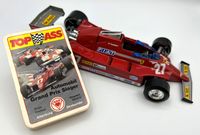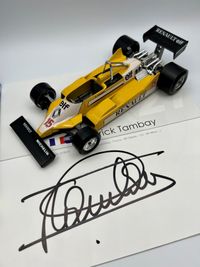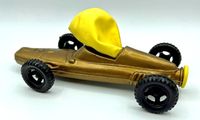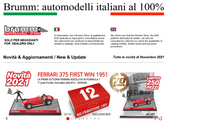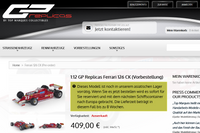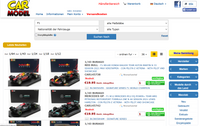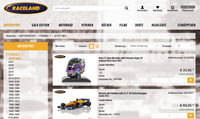Blogs 2022
On the retirement of Sebastian Vettel
Sebastian Vettel has left Formula 1. After 16 years and 299 Grands Prix, the four-time Formula 1 World Champion has ended his career. Only Lewis Hamilton and Michael Schumacher (7 each) and Juan-Manuel Fangio (5) have won more titles than the man from Heppenheim (Germany). He is tied with Alain Prost, although Prost did not win his titles consecutively. Vettel was world champion four times in a row from 2010 to 2013. Each time for Red Bull Racing.
However, the 35-year-old did not start his Formula 1 career with Red Bull. He owes his Formula 1 debut to BMW-Sauber. Vettel replaced Robert Kubica, who was injured, as a substitute driver at the 2007 US Grand Prix in Indianapolis. Three races later, at the Hungarian Grand Prix, Vettel was driving for Toro Rosso, Red Bull Racing's B team. From then on, things went steeply upwards. Without having been on the podium before, Vettel secured his first GP victory at the 2008 Italian Grand Prix in Monza. Vettel had dominated that weekend in constant rain and difficult conditions. His first victory was never in danger. And 52 more were to follow.
Vettel scored 38 of them during his time at Red Bull Racing (from 2009 to 2014). And he celebrated another 14 victories as a driver of the Scuderia Ferrari. Vettel missed out on the world championship title he was aiming for there. He finished second in both 2017 and 2018. In his last season for Ferrari in 2020, not much went right. With only one podium finish, he only made it to 13 th place. He then switched to Aston Martin for two years and finished twelfth in the World Championship twice. Vettel no longer broke the big ropes at the traditional British brand. His departure from Formula 1 at the end of 2022 was therefore a logical consequence.
How good Vettel actually was – that's a matter of dispute among experts. While some considered the German an exceptional talent, others thought he was a driver who could only win his titles in the care of Red Bull. The fact is: Vettel managed to get the whole team behind him at Red Bull (just like Max Verstappen today) and to provide him with a car that was perfectly tuned for him. Later, at Ferrari, he did not manage to do this again. Like his predecessor Fernando Alonso, Vettel also failed in the fight for the world championship crown with the squad from Maranello. All models of Vettel, who gave each of his Formula 1 cars a girl's name, are available in 1:43rd and 1:18th scale, starting with the test version of the BMW-Sauber from 2006, the Toro Rosso and Red Bull models and the two Aston Martins (all available from Minichamps, some also from Spark). For the Ferrari models, the collector has to make do with competitor products. First and foremost Looksmart or BBR. Vettel models are also available from Bburago in 1:43rd, 1:32nd and 1:18th scale. My special favourite is and remains the 1:43rd scale model of the 2008 Monza GP and of his first victory for Red Bull at the 2009 Chinese GP. Minichamps released both models in quantities of 9999 and 6192 respectively. They are not rare in that sense, but they are the models of Vettel's first F1 successes. And that makes them special.
Sebastian Vettel hat die Formel 1 verlassen. Nach 16 Jahren und 299 Grands Prix hat der viermalige Formel-1-Weltmeister den Helm an den berühmten Nagel gehängt. Nur Lewis Hamilton und Michael Schumacher (je 7) sowie Juan-Manuel Fangio (5) haben mehr Titel geholt als der Mann aus Heppenheim (D). Mit Alain Prost liegt er gleichauf, wobei Prost seine Titel nicht hintereinander gewann. Vettel war von 2010 bis 2013 vier Mal «en suite» Weltmeister. Und das stets für Red Bull Racing.
Seine Formel-1-Karriere startete der heute 35-Jährige allerdings nicht bei Red Bull. Seinen Formel-1-Einstieg verdankt er BMW-Sauber. Dort ersetzte Vettel als Ersatzfahrer 2007 beim Grossen Preis der USA in Indianapolis den rekonvaleszenten Robert Kubica. Drei Rennen später, beim Grossen Preis von Ungarn, sass Vettel dann im Cockpit von Toro Rosso, dem B-Team von Red Bull Racing. Von da an ging es steil aufwärts. Ohne zuvor auf dem Podium gestanden zu haben, sicherte sich Vettel 2008 beim Grossen Preis von Italien in Monza seinen ersten GP-Sieg. Vettel hatte das Wochenende bei Dauerregen und schwierigen Verhältnissen dominiert. Sein erster Sieg war nie in Gefahr. Und es sollten noch 52 weitere folgen.
38 davon fuhr Vettel in der Zeit bei Red Bull Racing ein (von 2009 bis 2014). 14 weitere Triumphe feierte «Seb» als Fahrer der Scuderia Ferrari. Den dort angepeilten WM-Titel verpasste Vettel. 2017 und 2018 wurde er jeweils WM-Zweiter. In seinem letzten Ferrari 2020 passte dann nicht mehr viel zusammen. Mit einem einzigen Podiumsplatz schaffte er es lediglich auf Rang 13. Danach wechselte er für zwei Jahre zu Aston Martin und wurde zwei Mal WM-Zwölfter. Die grossen Stricke zerriss Vettel bei der britischen Traditionsmarke nicht mehr. Der Abschied aus der Formel 1 Ende 2022 war daher die logische Konsequenz.
Wie gut Vettel tatsächlich war – darüber streiten sich die Experten. Während der Deutsche für einige als Ausnahmekönner galt, hielten ihn andere für einen Fahrer, der seine Titel nur in der Obhut von Red Bull einfahren konnte. Fakt ist: Vettel hatte es bei Red Bull geschafft (so wie heutzutage Max Verstappen) das ganze Team hinter sich zu kriegen und ihm ein Auto hinzustellen, das perfekt auf ihn abgestimmt war. Später bei Ferrari ist ihm dieses Kunststück nicht nochmals gelungen. Wie sein Vorgänger Fernando Alonso scheiterte auch Vettel bei den Roten im Kampf um die WM-Krone.
Von Vettel, der jedem seiner Formel-1-Autos einen Mädchennamen gab, gibt es sämtliche Modelle in 1:43 und 1:18. Angefangen mit der Testversion des BMW-Sauber von 2006 über die Toro-Rosso- und Red-Bull-Modelle bis hin zu den beiden Aston Martins (allesamt bei Minichamps erhältlich, einige davon auch bei Spark). Für die Ferrari-Modelle muss der Sammler auf Konkurrenzprodukte ausweichen. Allen voran auf Looksmart oder BBR. Vettel-Modelle gibt es auch von Bburago in den Massstäben 1:43, 1:32 und 1:18. Mein spezieller Favorit ist und bleibten die 1:43-Verkleinerung vom GP Monza 2008 sowie von seinem ersten Sieg für Red Bull beim China-GP 2009. Beide Modelle hat Minichamps in einer Stückzahl von 9999 respektive 6192 herausgebracht. Sie sind so gesehen nicht rar, aber es sind eben die Modelle von Vettels ersten F1-Erfolgen. Und das macht sie speziell.
Patrick Tambay, 1949-2022
Patrick Tambay has died at the age of 73. The former Formula 1 driver from France (114 Grands Prix) had been suffering from Parkinson's disease for years. Tambay was not one of the absolute top stars in GP racing. Nevertheless, he is fondly remembered by many fans – as a quick racing driver with impeccable manners.
Tambay became famous in Formula 1 in 1982. After the death of his friend Gilles Villeneuve in Zolder, Belgium, Tambay, who was cockpit-less at that time, stepped in at Ferrari. The task was anything but easy. Villeneuve was not only the favourite of company founder Enzo Ferrari, the Tifosi literally worshipped the Canadian. But Tambay solved this difficult job with bravura. Already in the second race at Brands Hatch, the son of a Parisian jeweller became third. At the German Grand Prix in Hockenheim, his fourth outing for Ferrari, Tambay won his first Grand Prix. At the same time, the serious practice accident of team-mate and compatriot Didier Pironi made him team leader.
In 1983, in his second year at Ferrari, René Arnoux challenged him for this role. Tambay's compatriot, who had recently joined the Scuderia, was very popular with Enzo Ferrari because Arnoux's wild manner reminded him of Villeneuve. Nevertheless, Tambay was also an important part of the Maranello squad in 1983. With 40 championship points (fourth in the world championship), Tambay contributed to Ferrari winning the Constructors' World Championship in 1983 as well as in 1982. He was on pole four times in 1983. At the Grand Prix of Imola he secured his second and last GP victory.
Because Ferrari chose Michele Alboreto as second driver alongside Arnoux in 1984, Tambay had to leave the Scuderia for the Renault works team. There he didn’t get happy. Tambay's time with the French team was marked by numerous retirements. Nevertheless, he was on the podium three times between 1984 and 1985. In 1986 he switched to the team of US millionaire Carl Haas, whom he knew from CanAm. A fifth place at the Austrian Grand Prix was his best result. After that, Tambay turned his back on Formula 1 and competed in sports car races, the Dakar Rally and ice races.
Like many of his French racing driver colleagues, Tambay also entered racing through the Ecole Winfield and sponsor elf. He spent three years in Formula 2, but without winning the title there. In 1977 he made his Formula 1 debut for Ensign at the British Grand Prix. In 1978 and 1979 he drove for McLaren. After zero points in the second season, Tambay had to leave. His Formula 1 career seemed to be at an end and he switched back to the CanAm series, won it in 1980 and returned to Teddy Yip and his racing team Theodore in 1981. In 1982, the man who after his career was also deputy mayor of his home municipality of Le Cannet in the south of France, would have been driving for Arrows. But during the drivers' strike in Kyalami, Tambay had enough. Disgusted by the political games, he withdrew before returning – sad as the story is – as Villeneuve's replacement.
The Tambay name lives on in motorsport through his son Adrien. The 31-year-old is known from the DTM and won the ETCR series this year in a Cupra E racer.
The cars that Tambay drove during his Formula 1 career are (almost) all available in 1/43rd scale. Spark has the Ensign from 1977 and the Theodore TY01 with the unusual front wing design from 1981 in its range. The McLaren M26 from 1978 is available from Minichamps in Marlboro and Löwenbräu livery. The same applies to the 79 version. The Ferrari 126C2 from 1982 can be ordered from Brumm. There are various (inexpensive) versions. For the Ferrari 126 C2B, it is worth waiting for the model from GP Replicas. This should actually appear in the fourth quarter of 2022. For the two Renault cars from 1984 and 1985 as well as the Lola from 1986, Spark steps in again. Only the 1981 Ligier (eight races as replacement of Jean-Pierre Jabouille) and the Surtees TS19, with which Tambay failed to qualifying at the 1977 French GP, have not been released yet.
There are also cars in larger scales (at Bburago) which are dedicated to Patrick Tambay. But the Frenchman never drove them in real life. For example, the Ferrari 126CK (model of 1981), the Renault RE30 (ditto, both in 1:24) or the Ferrari 312T5 (1980) in 1:14.
Patrick Tambay ist im Alter von 73 Jahren gestorben. Der ehemalige Formel-1-Pilot aus Frankreich (114 Grands Prix) litt seit Jahren an der Parkinson-Krankheit. Tambay zählte im GP-Rennsport nicht zu den absoluten Top-Stars. Dennoch ist er vielen Fans in bester Erinnerung – als schneller Rennfahrer mit tadellosen Umgangsformen.
Berühmt wurde Tambay in der Formel 1 1982. Nach dem Tod seines Freundes Gilles Villeneuve im belgischen Zolder sprang der damals cockpitlose Tambay bei Ferrari ein. Die Aufgabe war alles andere als leicht. Villeneuve war nicht nur der Liebling von Firmengründer Enzo Ferrari, die Tifosi verehrten den Kanadier regelrecht. Doch Tambay löste diese schwierige Aufgabe mit Bravour. Schon im zweiten Rennen in Brands Hatch stand der Sohn eines Pariser Juweliers als Dritter auf dem Podium. Beim Grossen Preis von Deutschland in Hockenheim, dem vierten Einsatz für Ferrari, gewann Tambay seinen ersten Grand Prix. Gleichzeitig wurde er durch den schweren Trainingsunfall von Teamkollege und Landsmann Didier Pironi zum Teamleader.
Diese Rolle machte ihm 1983, in seinem zweiten Ferrari-Jahr, René Arnoux streitig. Der neu zur Scuderia gestossene Landsmann von Tambay stand bei Enzo Ferrari hoch im Kurs, weil ihn die wilde Art von Arnoux an Villeneuve erinnerte. Nichtsdestotrotz war Tambay auch 1983 wichtiger Bestandteil der Truppe aus Maranello. Denn mit seinen 40 WM-Punkten (WM-Vierter) trug Tambay dazu bei, dass Ferrari nach 1982 auch 1983 die Konstrukteurs-WM gewann. Vier Mal stand er 1983 auf der Pole-Position. Beim Grand Prix von Imola sicherte er sich seinen zweiten und letzten GP-Sieg.
Weil Ferrari 1984 auf Michele Alboreto als zweiten Fahrer neben Arnoux setzte, musste Tambay die Scuderia in Richtung Renault-Werksteam verlassen. Glücklich wurde er dort nicht. Zahlreiche Ausfälle prägten Tambays Zeit bei den Gelben. Immerhin: Drei Mal stand er zwischen 1984 und 1985 nochmals auf dem Podium. 1986 wechselte er zum Team von US-Millionär Carl Haas, den er noch aus gemeinsamen CanAm-Tagen kannte. Ein fünfter Platz beim Grand Prix von Österreich war das beste Ergebnis. Danach kehrte Tambay der Formel 1 den Rücken, bestritt Sportwagenrennen, die Rallye Dakar sowie Eisrennen.
Wie viele seiner französischen Rennfahrerkollegen stieg auch Tambay über die Ecole Winfield und Sponsor elf in den Rennsport ein. Drei Jahre verbrachte er in der Formel 2, ohne dort jedoch den Titel zu gewinnen. 1977 gab er beim Grossen Preis von Grossbritannien seinen Formel-1-Einstand bei Ensign. 1978 und 1979 fuhr er für McLaren. Nach einem Nuller in der zweiten Saison musste Tambay seine Koffer packen. Seine Formel-1-Karriere schien am Ende zu sein. Tambay wechselte zurück in die CanAm-Serie, gewann diese 1980 und kehrte 1981 zu Teddy Yip und dessen Rennstall Theodore zurück. 1982 hätte der Mann, der nach seiner Karriere u.a. auch stellvertretender Bürgermeister seiner Heimatgemeinde Le Cannet in Südfrankreich war, für Arrows fahren sollen. Doch beim Fahrerstreik in Kyalami wurde es Tambay zu bunt. Angewidert von den politischen Spielchen zog er sich zurück, ehe er dann – so traurig die Geschichte ist – als Villeneuve-Ersatz zurückkehrte.
Der Name Tambay lebt im Motorsport durch seinen Sohn Adrien weiter. Der 31-Jährige ist aus der DTM bekannt und gewann in diesem Jahr in einem Cupra E-Racer die ETCR-Serie.
Die Fahrzeuge, die Tambay während seiner Formel-1-Karriere bewegte, sind (fast) alle in 1:43 erhältlich. Den Ensign von 1977 sowie den Theodore TY01 mit der eigenwilligen Frontflügel-Konstruktion von 1981 hat Spark im Programm. Den McLaren M26 von 1978 gibt es bei Minichamps in Marlboro- und Löwenbräu-Lackierung. Gleiches gilt für die 79er-Version. Den 1982er-Ferrari 126C2 würde ich bei Brumm ordern. Da gibt es verschiedene (preiswerte) Versionen. Beim Ferrari 126 C2B lohnt es sich, auf das Modell von GP Replicas zu warten. Dies sollte eigentlich im vierten Quartal 2022 erscheinen. Bei den beiden Renault-Fahrzeugen von 1984 und 1985 sowie beim Lola von 1986 springt wieder Spark ein. Einzig den Ligier von 1981 (acht Rennen als Ersatz von Jean-Pierre Jabouille) und den Surtees TS19, mit dem Tambay an der Quali-Hürde beim Frankreich-GP 1977 scheiterte, sind mir bisher noch nie untergekommen.
Auch in grösseren Massstäben (bei Bburago) gibt es Fahrzeuge mit der Aufschrift Patrick Tambay. Diese hat der Franzose in echt aber nie gefahren. So zum Beispiel den Ferrari 126CK (Modell von 1981), den Renault RE30 (dito, beide in 1:24) oder den Ferrari 312T5 (1980) in 1:14.
Ready, steady, go!
Racing cars have fascinated both, young and old, already hundred years ago. Toy car manufacturers recognised this early on. And as early as the twenties and thirties, they produced corresponding toy cars. Soon it was not only about the models themselves. More and more companies were looking for solutions to make toys even more realistic. The best-known manufacturer of "movable" toys at this time was Schuco. Whether a drumming monkey, the reversible car described in the Schuco chapter or a clown playing the violin – Schuco managed to bring toys to life with the help of drive mechanisms.
Models of racing cars were naturally predestined for this type of toy. And there was no lack of imitators and ideas for different methods of locomotion. Speaking about Schuco the toy manufacturer from Nuremberg launched the so-called micro-racers in the fifties. They had a spring-loaded motor that could be wound up with the help of a spanner that came along with the car. But the Micro-Racers were not only popular because of their wind-up mechanism. They also have a steering mechanism. Like for example the Mercedes W196, where the steering is attached at the end of the exhaust pipe.
In the fifties, there were already other types of driving mechanisms. The Italian toy manufacturer Lima, for example, had a Ferrari 555 Supersqualo with a battery-powered cable remote control. Whereby the term remote control is somewhat misleading. Because the car is connected with a cable, the playing radius is quite limited. The same system – simply with a steering wheel instead of a toggle switch on the remote control – was available at ELM Toys from Hong Kong for a Vanwall and a Cooper.
The same Vanwall is also available with friction drive. But what exactly is a friction drive? A friction motor essentially consists of a flywheel and a reduction gear. The flywheel can be set in motion via the wheels of the toy (or via a friction wheel located on the underside). If you release the model after pushing it forward, it continues to move driven by the momentum of the flywheel until the rotational energy of the flywheel is used up. This type of toy model was widespread – especially with plastic, but also tin toys from the Far East.
In addition to spring-work and friction motors, there were other types of driving mechanisms. And there were often no limits to the imagination. One popular way of making toys "move" was a catapult. There are several examples of this in my collection. All of them are working in an identical way. And it doesn’t matter if the models were made in Germany, Hong Kong or Spain. You can shoot the models with a push button. Some of them even have a garage as a launching pad.
A racing car toy produced in France that appeared in 1961 works in a similar way like the catapults. The difference is that the catapult (with a spring) works like a jet engine and shoots off together with the model when you operate it. The little toy cars were not for sale. They could be ordered by Gringoire, a manufacturer of wafer, in exchange for vouchers. According to a newspaper advertisement, the models were available in four different colours.
Magnets were also used as a mechanism to move toy cars forward. The best-known example came from Germany: the Magneto Formula 1 Race Car. It was available in different colours and the cars were described as BRM, Cooper, Lotus or Ferrari. The approximately 5-centimetre plastic models from Western Germany were advertised with the slogan: Drive without an engine and without wear and tear. The trick behind it: There is a magnet in the rear of the model. With a second magnet mounted on a rod, the vehicle can be moved in the desired direction as if by magic.
The same principle was followed by the Atom-Car; a magnetic racing car called the Mercedes Monoposto 300, also produced in Germany by Magneto. According to the inscription on the packaging, the model was made for the German, American and British markets and was produced towards the end of the 1950s.
Marx used a simple principle in the late seventies to put the spurs to a Ferrari 312 T2. To do this, the US toy manufacturer used a string that protrudes from the rear of the vehicle. To accelerate the model, you have to pull the string. This then winds up again inside the vehicle and thus provided the desired forward movement.
Another way to make toy cars move forward is the pull-back motor. With pull-back motors, you build up tension by pulling back (usually with the help of a torsion spring and various sized gears), which develops acceleration when released. Several manufacturers, especially in the seventies and eighties, based models on pull-back motors and, like Mattel/Hotwheels for example, launched entire race tracks that were very popular for children.
Even Minichamps produced some pull back models briefly. In the mid-nineties, the Aachen-based company, in cooperation with UT Models, launched three Formula One models from the 1995-season: the Ferrari 412T2, the Benetton B195 and the Sauber C14. Also equipped with pullback engines are the six Lotus models from Suntory, a Japanese manufacturer of drinks, who presumably had the models produced as promotional gifts.
The funniest form of movement, in my opinion, came from a manufacturer in the USA. He had made a model similar to a Gordini T16 with an exhaust pipe to which a balloon could be attached. When the air escapes from the balloon, the plastic model moves forward...
Rennautos haben Gross und Klein schon vor hundert Jahren fasziniert. Hersteller von Spielzeugautos haben das früh erkannt. Und schon in den Zwanziger- und Dreissigerjahren entsprechende Spielzeugautos produziert. Schon bald ging es nicht nur um die Modelle an sich. Immer mehr Firmen suchten nach Lösungen, Spielzeug noch realistischer zu machen. Der bekannteste Hersteller von «beweglichem» Spielzeug in dieser Zeit war Schuco. Beim Hersteller aus Nürnberg waren nahezu alle Spielzeuge in Bewegung. Ob nun ein trommelnder Affe, das im Kapitel Schuco beschriebene Wendeauto oder ein Geige spielender Clown – mit Hilfe von Antriebsmechanismen schaffte es Schuco, Spielzeug zum Leben zu erwecken.
Modelle von Rennautos waren für diese Art von Spielzeug natürlich prädestiniert. Und an Nachahmer und Ideen für unterschiedliche Fortbewegungsmethoden fehlte es auch nicht. Aber bleiben wir vorerst bei Schuco. In den Fünfzigerjahren brachte der deutsche Spielzeughersteller die so genannten Micro-Racer auf den Markt. Diese verfügen über einen Federwerkmotor, den man mit Hilfe eines mitgelieferten Schraubenschlüssels aufziehen kann. Die Micro-Racer waren aber nicht nur wegen ihres Aufziehmechanismus beliebt. Sie verfügen auch über eine Lenkung. Beim Mercedes W196 ist diese am Ende des Auspuffrohrs angebracht.
In den Fünfzigerjahren gab es bereits andere Antriebsarten. Der italienische Spielzeughersteller Lima beispielsweise hatte einen Ferrari 555 Supersqualo mit einer Batterie betriebenen Kabelfernsteuerung an. Wobei der Begriff Fernsteuerung etwas irreführend ist. Da das Auto mit einem Kabel verbunden ist, ist der Spielradius begrenzt. Dasselbe System – einfach nur mit einem Lenkrad statt einem Kippschalter an der Fernbedienung – gab es für einen Vanwall und einen Cooper bei ELM Toys aus Hong Kong.
Denselben Vanwall gibt es auch mit Friktionsantrieb. Doch was genau ist ein Friktionsantrieb? Ein Friktionsmotor (Friktion = Reibung) besteht im Wesentlichen aus einem Schwungrad und einem Untersetzungsgetriebe. Über die Räder des Spielzeugs (oder über ein auf der Unterseite liegendes Reibrad) kann das Schwungrad in Bewegung gesetzt werden. Lässt man das Modellfahrzeug los, so fährt es durch den Schwung des Schwungrades angetrieben weiter, bis die Rotationsenergie des Schwungrades aufgebraucht ist. Diese Art von Spielzeugmodellen war weit verbreitet – vor allem bei Plastik-, aber auch Blech-Spielzeug aus Fernost.
Neben Federwerk- und Friktionsmotoren gab es noch weitere Antriebsarten. Und dabei waren der Fantasie oft keine Grenzen gesetzt. Eine beliebte Art, Spielzeug «beweglich» zu machen, war das Katapult. Hierfür gibt es in meiner Sammlung verschiedene Exemplare. Wobei das Prinzip bei allen identisch ist. Sei es nun bei Modellen aus Deutschland, Hong Kong oder Spanien. Per Knopfdruck kann man die Modelle abschiessen. Einige davon haben dafür sogar extra eine Garage als Startrampe.
Ähnlich wie die Katapulte funktioniert eines in Frankreich produziertes Rennwagenspielzeug, das 1961 erschienen ist. Mit dem Unterschied, dass das Katapult (mit einer Feder) ähnlich wie ein Triebwerk funktioniert und mitsamt des Modells davonschiesst, wenn man es betätigt. Die kleinen Spielzeugautos gab es nicht im Verkauf. Man konnte sie bei Waffelhersteller Gringoire gegen Abgabe von Gutscheinen bestellen. Einer Zeitungsanzeige zufolge waren die Modelle in vier verschiedenen Farben erhältlich.
Als Fortbewegungsart für Spielzeugautos dienten auch Magnete. Das bekannteste Beispiel stammt aus Deutschland: der Magneto Formula 1 Race Car. Diesen gab es in verschiedenen Farben als BRM, Cooper, Lotus und Ferrari. Beworben wurden die rund 5 Zentimeter grossen Plastikmodelle aus Western-Germany mit dem Slogan: Fahren ohne Motor – ohne Abnützung. Der Trick dahinter: Im Heck des Modelles gibt einen Magneten. Mit einem zweiten Magneten, der an einem Stäbchen montiert ist, kann man so das Fahrzeug wie von Geisterhand in die gewünschte Richtung bewegen.
Dasselbe Prinzip verfolgte der Atom-Car; ein ebenfalls in Deutschland bei Magneto produziertes Magnet-Rennauto mit der Bezeichnung Mercedes Monoposto 300. Der Beschriftung auf der Verpackung zufolge wurde das Modell für den deutschen, den amerikanischen und britischen Markt hergestellt und zwar gegen Ende der Fünfzigerjahre.
Ein einfaches Prinzip nutzte Marx in den späten Siebzigerjahren, um einem Ferrari 312 T2 die Sporen zu geben. Hierzu verwendete der US-Spielzeughersteller eine Schnur, die aus dem Heck des Fahrzeugs ragt. Um das Modell zu beschleunigen, muss man an der Schnur ziehen. Diese wickelt sich dann im Inneren des Fahrzeugs wieder auf und sorgte so für die gewünschte Vorwärtsbewegung.
Eine weitere Art, Spielzeugautos Leben einzuhauchen, ist der Rückziehmotor. Bei Rückziehmotoren baut man durch das Zurückziehen eine Spannung auf (meistens mit Hilfe einer Torsionsfeder und verschieden grossen Zahnrädern), welche durch das Loslassen die Beschleunigung entwickelt. Mehrere Hersteller haben vor allem in den Siebziger- und Achtzigerjahren Modelle auf Modelle mit Rückziehmotoren gesetzt und wie beispielsweise Mattel/Hotwheels ganze Rennbahnen, die bei Kindern sehr populär waren, auf den Markt gebracht.
Selbst Minichamps ist kurz auf den Pullback-Zug aufgesprungen. Mitte der Neunzigerjahre haben die Aachener in Zusammenarbeit mit UT Models drei F1-Modelle aus der Saison 1995 ins Regal gestellt: den Ferrari 412T2, den Benetton B195 und den Sauber C14. Ebenfalls mit Pullback-Motoren ausgerüstet sind die sechs Lotus-Modelle von Suntory, einem japanischen Getränkehersteller, der die Modelle vermutlich als Werbegeschenke produzieren liess.
Die witzigste Fortbewegungsart stammt meines Erachtens von einem Hersteller aus den USA. Dieser hatte ein Modell, das einem Gordini T16 gleicht, mit einem Auspuffrohr angefertigt, an welchem man einen Ballon anhängen konnte. Entweicht die Luft aus dem Ballon, bewegt sich das Plastikmodell nach vorne…







